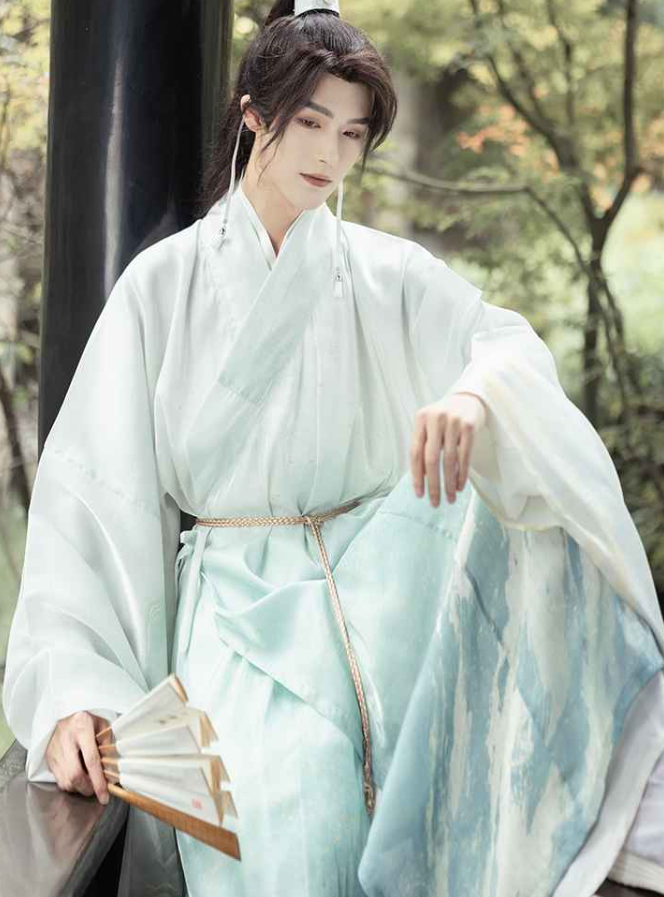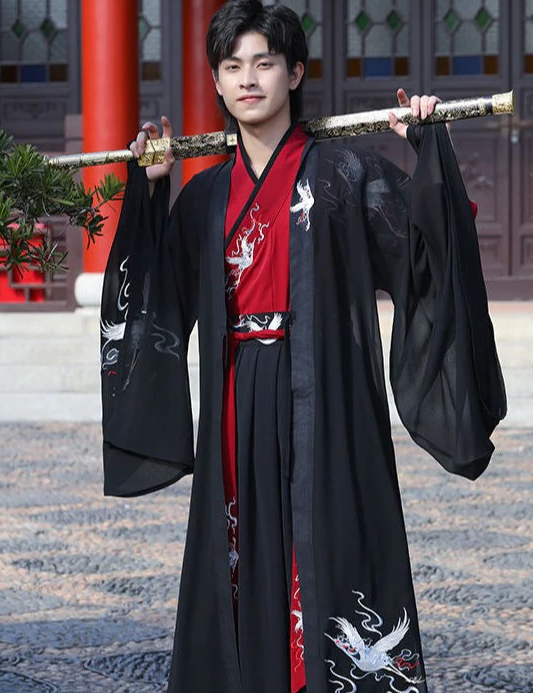A Chinese male Hanfu is a traditional Chinese garment with components like Yi (upper garment), Chang (lower garment), and Pao (robe).
Components of Male Hanfu
Yi (Upper Garment)
The Yi is the quintessential upper garment in male Hanfu attire. This type of clothing has undergone various modifications over centuries but has always retained its basic form. Typically, it features a cross-collar, wrapped right over left, and is secured with a sash at the waist. It’s a versatile piece that can be worn for both casual and formal occasions.
Materials used for making Yi range from cotton for everyday wear to fine silk for more formal settings. Embroidery and patterns on the Yi often carry significant symbolism, such as dragons or phoenixes, representing nobility and grace.
For those interested in the evolution of this garment, the Yi Wikipedia page offers a detailed history.

Chang (Lower Garment)
The Chang serves as the lower garment in a traditional Hanfu ensemble. It usually takes the form of a skirt or a pair of trousers. Skirt-style Chang is pleated and can have various designs, including embroidered patterns and symbolic motifs like clouds or mountains, often inspired by natural elements.
When trousers are worn, they are generally loose and may have a tapered style towards the ankle. The trousers can be held up by a fabric belt or sash.
The Chang Wikipedia page can provide further information about its historical variations.
Pao (Robe)
The Pao is a long robe often worn over the Yi for formal events and ceremonies. Historically, it was a status symbol, as the patterns and materials used indicated the wearer’s social rank. These robes can be either full-length, covering from neck to ankle, or shorter versions that only reach the knee.
You can commonly find Pao made of luxurious materials like silk, brocade, and even embroidered with gold thread for especially grand occasions.
For an in-depth look at the Pao, you might find the Pao Wikipedia page beneficial.
Ru (Open Cross-collar Garment)
The Ru is another popular upper garment, featuring an open cross-collar design. Unlike the Yi, the Ru does not have a sash and is often worn open or overlaid on other layers. It’s suitable for both formal and casual settings.
Materials used for Ru are similar to those of the Yi, ranging from everyday cotton to more luxurious silks and brocades. The Ru may also be decorated with intricate embroidery, showcasing motifs like peonies or chrysanthemums, which carry their own symbolic meanings.
Historical Context
Han Dynasty Roots
The Hanfu clothing style takes its name from the Han Dynasty, one of the most influential periods in Chinese history. During this era, clothing wasn’t just a utilitarian need but a marker of social status and cultural identity. The garments from this time laid the groundwork for what we today recognize as Hanfu. Elites often wore luxurious fabrics like silk, while commoners usually wore hemp or cotton.
Different types of Hanfu existed for various occasions, from everyday wear to special ceremonies. The Yi, Chang, Pao, and Ru were all common elements during the Han Dynasty, albeit in slightly different forms than today. It was a period of experimentation and refinement in Chinese clothing.
For an in-depth look into the Han Dynasty’s influence on Chinese culture and clothing, the Han Dynasty Wikipedia page is a great resource.
Evolution Across Dynasties
As China transitioned through different dynasties, each era brought about its own set of influences on Hanfu. For example, during the Tang Dynasty, a more open and international environment led to adaptations in clothing styles, incorporating elements from as far as Persia and Central Asia.
The Ming Dynasty saw a resurgence in ethnic Han culture, including the re-adoption and standardization of Hanfu. New forms and styles emerged, which were both innovative and deeply rooted in tradition.
In modern times, the Hanfu movement seeks to bring back these traditional forms of clothing as a means of cultural expression and pride. This is more than just a fashion trend; it’s a form of reconnecting with China’s rich sartorial history.
For those interested in how Hanfu evolved across different Chinese dynasties, visiting the Hanfu Wikipedia page can provide a broader historical context.
Variations Across Regions
Northern Hanfu Styles
The northern regions of China, with their colder climates, have their own unique styles of Hanfu. Fabrics such as wool and heavier silks are commonly used to provide warmth. One characteristic feature is the use of fur or thick lining in the robes, especially the Pao. Longer sleeves and wider collars are also common to help retain heat.
You’ll often see the use of darker colors in northern Hanfu, like blacks, browns, and navy blues, as these shades are considered more practical and also carry certain symbolic meanings. The design may incorporate Mongol or Manchu influences due to the historical context of these neighboring regions.
For a deeper understanding of how the northern climate and culture have influenced Hanfu, you might want to consult the Hanfu Wikipedia page.
Southern Hanfu Styles
In contrast, the southern regions of China feature a warmer, more humid climate, which has led to lighter and more breathable styles of Hanfu. Linen and thin silk are often the fabrics of choice, and you’ll see a preponderance of brighter colors like white, light blue, and light green, symbolizing the lush landscapes of the south.
Southern styles often include shorter robes and skirts, and it’s not uncommon to see sleeveless options as well. Floral and aquatic motifs, such as lotus and fish patterns, are popular in embroidery, symbolizing the natural scenery of the region.
Occasions for Wearing Hanfu
Traditional Festivals
Hanfu clothing shines brightest during traditional festivals like the Lunar New Year, Mid-Autumn Festival, and Dragon Boat Festival. During these times, people don these garments as a way of connecting with their heritage. Specific types of Hanfu may be worn depending on the festival. For example, brighter and more colorful Hanfu are often chosen for the Lunar New Year to symbolize prosperity and good fortune for the year ahead.
If you’re interested in learning about Chinese festivals where Hanfu is traditionally worn, the Traditional Chinese Festivals Wikipedia page offers more information.
Casual Wear
In recent years, the Hanfu movement has brought this traditional attire into daily life. Young people, in particular, enjoy wearing Hanfu casually, whether they’re going out with friends, attending school, or even just lounging at home. Casual Hanfu typically features simpler designs and materials like cotton to make them more comfortable for everyday wear.
To learn more about the modern-day Hanfu movement, you can check out the Hanfu Wikipedia page.
Rituals and Ceremonies
Hanfu also holds a significant place in various Chinese rituals and ceremonies, such as weddings, ancestral rites, and Confucian ceremonies. In these settings, the clothing isn’t just about aesthetics but serves a symbolic role. The garments are often more elaborate, featuring intricate embroidery and the use of luxurious materials like silk and brocade.
For those interested in the ritualistic aspects of Hanfu, the Chinese Rituals and Ceremonies Wikipedia page can provide more details.

Symbolism in Male Hanfu
Colors and Their Meanings
In traditional Chinese culture, colors are loaded with meaning, and this symbolism extends to Hanfu as well. Red, for example, represents good fortune and joy, making it a popular choice for festive occasions and ceremonies. Green signifies growth and harmony and is often used in Hanfu worn during spring festivals. Black and blue are generally associated with dignity and integrity, making them common in garments intended for formal or ceremonial use.
The use of color in Hanfu is not random but steeped in cultural significance. If you’re intrigued by the symbolism of colors in Chinese culture, the Color Symbolism in China Wikipedia page can offer a deeper understanding.
Patterns and Motifs
Hanfu clothing often features intricate patterns and motifs, each with its own set of meanings. Dragons, a powerful symbol of strength and good luck, are commonly seen in Hanfu worn by males, particularly in royal or noble settings. Phoenix patterns symbolize rebirth and immortality, while floral motifs like peonies and chrysanthemums represent beauty and prosperity.
Other common patterns include geometric shapes, like circles and squares, which might symbolize the Earth and the heavens, respectively. Cloud motifs are often used to symbolize the connection between humans and the divine.
How to Wear Male Hanfu
Draping Techniques
Wearing Hanfu is not as straightforward as putting on a modern t-shirt and jeans. It involves specific draping techniques that respect the garment’s historical and cultural background. The basic elements like Yi (upper garment) and Chang (lower garment) often come with sashes or belts to help hold the pieces in place. When wearing a Ru or Pao, the cross-collars should be neatly aligned, and the sash should be tied in a particular way to achieve the traditional appearance.
You can find tutorials and guides on how to correctly drape Hanfu on platforms like YouTube, but for a deeper dive into the historical methods, the Hanfu Wikipedia page is also a valuable resource.
Pairing with Accessories
Accessories can elevate your Hanfu outfit to another level. For men, options include hats, ornate belts, and even traditional shoes. In ancient times, different types of hats indicated one’s social status, so it’s an aspect worth considering when planning a historically accurate outfit.
Jewelry like jade pendants or wooden beads can also complement the Hanfu, adding an extra layer of symbolism and cultural depth. These details, while subtle, contribute significantly to the overall aesthetics and meaning of the attire.
For more insights on traditional Chinese accessories, you can visit the Chinese Clothing Wikipedia page.
Modern Adaptations
Today, many designers and enthusiasts are modernizing Hanfu to adapt to contemporary lifestyles. This includes the use of modern fabrics, the incorporation of pockets, and the simplification of some traditional draping methods. Some modern Hanfu even feature zippers and buttons, which are obviously not traditional but make the garments more practical for everyday wear.
What are the main components of a male Hanfu?
How much does a traditional male Hanfu typically cost?
What fabrics are commonly used in male Hanfu?
What is the typical size range for male Hanfu?
How long does it take to put on a male Hanfu properly?
What are the advantages and disadvantages of wearing Hanfu?
Are there modern adaptations of male Hanfu?
How do the styles differ between Northern and Southern Hanfu?
-
- Northern styles often use heavier materials like wool and have darker colors, while Southern styles prefer lighter fabrics like linen and feature brighter colors.